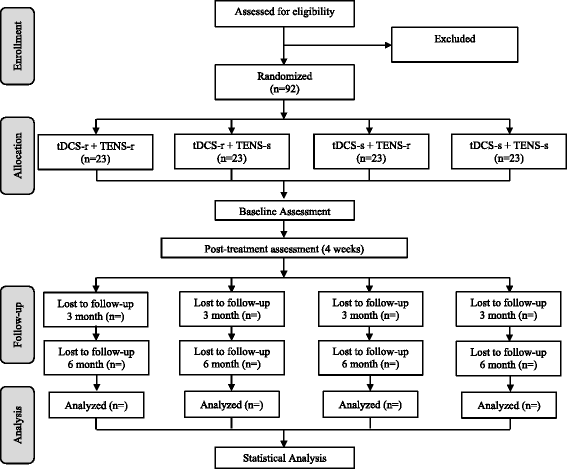Analgesic efficacy of cerebral and peripheral electrical stimulation in chronic nonspecific low back pain: a randomized, double-blind, factorial clinical trial
- PMID: 25636503
- PMCID: PMC4323215
- DOI: 10.1186/s12891-015-0461-1
Analgesic efficacy of cerebral and peripheral electrical stimulation in chronic nonspecific low back pain: a randomized, double-blind, factorial clinical trial
Abstract
Background: Chronic non-specific low back pain is a major socioeconomic public health issue worldwide and, despite the volume of research in the area, it is still a difficult-to-treat condition. The conservative analgesic therapy usually comprises a variety of pharmacological and non-pharmacological strategies, such as transcutaneous electrical nerve stimulation. The neuromatrix pain model and the new findings on the process of chronicity of pain point to a higher effectiveness of treatments that address central rather than peripheral structures. The transcranial direct current stimulation is a noninvasive technique of neuromodulation that has made recent advances in the treatment of chronic pain. The simultaneous combination of these two electrostimulation techniques (cerebral and peripheral) can provide an analgesic effect superior to isolated interventions. However, all the evidence on the analgesic efficacy of these techniques, alone or combined, is still fragmented. This is a protocol for a randomized clinical trial to investigate whether cerebral electrical stimulation combined with peripheral electrical stimulation is more effective in relieving pain than the isolated application of electrical stimulations in patients with chronic nonspecific low back pain.
Methods/design: Ninety-two patients will be randomized into four groups to receive transcranial direct current stimulation (real/sham) + transcutaneous electrical nerve stimulation (real/sham) for 12 sessions over a period of four weeks. The primary clinical outcome (pain intensity) and the secondary ones (sensory and affective aspects of pain, physical functioning and global perceived effect) will be recorded before treatment, after four weeks, in Month 3 and in Month 6 after randomization. Confounding factors such as anxiety and depression, the patient's satisfaction with treatment and adverse effects will also be listed. Data will be collected by an examiner unaware of (blind to) the treatment allocation.
Discussion: The results of this study may assist in clinical decision-making about the combined use of cerebral and peripheral electrical stimulation for pain relief in patients with chronic low back pain.
Trial registration: NCT01896453.
Figures
Similar articles
-
Electrical stimulation for chronic non-specific low back pain in a working-age population: a 12-week double blinded randomized controlled trial.BMC Musculoskelet Disord. 2013 Mar 28;14:117. doi: 10.1186/1471-2474-14-117. BMC Musculoskelet Disord. 2013. PMID: 23537462 Free PMC article. Clinical Trial.
-
Effectiveness of anodal transcranial direct current stimulation in patients with chronic low back pain: design, method and protocol for a randomised controlled trial.BMC Musculoskelet Disord. 2011 Dec 28;12:290. doi: 10.1186/1471-2474-12-290. BMC Musculoskelet Disord. 2011. PMID: 22204615 Free PMC article. Clinical Trial.
-
Transcranial Direct Current Stimulation Combined With Therapeutic Exercise in Chronic Low Back Pain: Protocol of a Randomized Controlled Trial.Phys Ther. 2020 Aug 31;100(9):1595-1602. doi: 10.1093/ptj/pzaa105. Phys Ther. 2020. PMID: 32526017
-
Transcutaneous electrical nerve stimulation (TENS) for pain management in sickle cell disease.Cochrane Database Syst Rev. 2020 Mar 3;3(3):CD012762. doi: 10.1002/14651858.CD012762.pub2. Cochrane Database Syst Rev. 2020. PMID: 32124977 Free PMC article.
-
Literature Review and Meta-Analysis of Transcutaneous Electrical Nerve Stimulation in Treating Chronic Back Pain.Reg Anesth Pain Med. 2018 May;43(4):425-433. doi: 10.1097/AAP.0000000000000740. Reg Anesth Pain Med. 2018. PMID: 29394211 Free PMC article.
Cited by
-
Searching for the optimal tDCS target for motor rehabilitation.J Neuroeng Rehabil. 2019 Jul 17;16(1):90. doi: 10.1186/s12984-019-0561-5. J Neuroeng Rehabil. 2019. PMID: 31315679 Free PMC article. Review.
-
Efficacy of Selected Electrical Therapies on Chronic Low Back Pain: A Comparative Clinical Pilot Study.Med Sci Monit. 2017 Jan 7;23:85-100. doi: 10.12659/msm.899461. Med Sci Monit. 2017. PMID: 28062862 Free PMC article. Clinical Trial.
-
Inverse Electrode Placement May Help to Improve Electrotherapeutic Effects in the Field of Chronic Pain Management.Korean J Pain. 2016 Jul;29(3):202-4. doi: 10.3344/kjp.2016.29.3.202. Epub 2016 Jul 1. Korean J Pain. 2016. PMID: 27413488 Free PMC article. No abstract available.
-
A Review on Treatment Approaches for Chronic Low Back Pain via Mulligans Movement With Mobilization and Physical Therapy.Cureus. 2022 Aug 18;14(8):e28127. doi: 10.7759/cureus.28127. eCollection 2022 Aug. Cureus. 2022. PMID: 36134056 Free PMC article. Review.
-
An Open-Label Comparative Study of the Impact of Two Types of Electrical Stimulation (Direct Current Neuromuscular Electrical Stimulation and Transcutaneous Electrical Stimulation) on Physical Therapy Treatment of Diabetic Peripheral Neuropathy.J Diabetes Res. 2025 Feb 4;2025:9970124. doi: 10.1155/jdr/9970124. eCollection 2025. J Diabetes Res. 2025. PMID: 39949402 Free PMC article. Clinical Trial.
References
-
- Brazilian Institute of Geography and Statistics (IBGE). Brazilian Institute of Geography and Statistics (IBGE). National Sampling Study of Households. A Panorama of Health in Brazil: access to and utilization of services, health conditions and risk factors and protection of health 2008. In: Book Brazilian Institute of Geography and Statistics (IBGE). Brazilian Institute of Geography and Statistics (IBGE): National Sampling Study of Households. A Panorama of Health in Brazil: access to and utilization of services, health conditions and risk factors and protection of health 2008.
Publication types
MeSH terms
Associated data
LinkOut - more resources
Full Text Sources
Other Literature Sources
Medical


